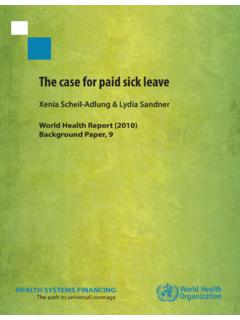Transcription of 171-2008 - mea.mpisoc.mpg.de
1 WHAT IS AN ADEQUATE STANDARD OF LIVING DURING RETIREMENT? Johannes Binswanger Daniel Schunk 171-2008 What Is an Adequate Standard of Livingduring Retirement? Johannes Binswanger Daniel Schunk September 25, 2008 AbstractMany economists and policy-makers argue that households do not save enoughto maintain an adequate standard of living during retirement. However, there isno consensus on the answer to the underlying question what this standard shouldbe, despite the fact that it is crucial for the design of saving incentives and pen-sion reforms. We address this question with a survey, individually tailored to eachrespondent s financial situation, conducted both in the and the findings are that adequate levels of retirement spendingexceed 70 percent ofworking life spending, and minimum acceptable replacementrates depend stronglyon words:Life cycle preferences, pension reform, replacement rates , retire-ment classification: D91, H55.
2 We would like to thank Arthur van Soest for very helpful support. We are also grateful to YvonneAdema, James Banks, Rotraut Binswanger, Jan Boone, Axel B orsch-Supan, Katie Carman, Norma Coe,Jeffrey Dominitz, Josef Falkinger, Ernst Fehr, Alia Gizatulina, Sally Gschwend, Eline van der Heijden,Hendrik J urges, Arie Kapteyn, Miles Kimball, Annamaria Lusardi, Olivia Mitchell, Hans-Theo Normann,Charles Noussair, Jan Potters, Maarten van Rooij, Claudia Sahm, MatthewShapiro, Jonathan Skinner,Karen van der Wiel, Joachim Winter, and to participants at the MESS workshop, at Netspar workshopsand seminar participants at Tilburg University and the University of Muenster for astute commentson this paper. Thanks also to Vera Toepoel from CentERdata and to Bas Weermanfrom RAND forprogramming our questionnaire and for valuable support, as well as to many other colleagues and friendsfor valuable feedback on our questionnaire.
3 Financial support from CentER and Netspar is gratefullyacknowledged. Corresponding Author;Department of Economics, CentER and Netspar, Tilburg University, 90153, 5000 LE Tilburg, The Netherlands; Institute for Empirical Research in Economics (IEW), University of Zurich, 8006 Zurich, IntroductionWhat level of spending during retirement do people consider desirable, given their lifetimebudget constraints? How does this level compare to spending during working life? Is therea minimum level of retirement spending which people want to maintain at all costs? Howmuch risk are individuals ready to bear in exchange for a higher expected standard ofliving during retirement? Finally, how do desired standards of living during retirementvary across the population?The answers to these questions provide a sound benchmark level for an adequatestandard of living during retirement and are thus important for three policy issues.
4 First,such a benchmark level allows us to address a concern expressed bymany economists andpolicy-makers: whether people are adequately prepared for , such abenchmark may serve as advice to individuals who find determining an adequate level ofretirement savings themselves difficult. Third, such a benchmark is highly informative forthe many countries around the globe that are currently considering reforming their pensionsystems, since any pension reform plan requires information about adequate benefit approaches for addressing the opening questions of this paper already approach is to assume that a constant relative risk aversion (CRRA) utility func-tion can approximate individuals preferences. Making specific assumptions about theparameters of this function as well as about other relevant variables such as interest ratesand equity returns allows for calibrating optimal consumption choices during old age andduring working life.
5 According to this approach, which we dubthe calibration approach,actual observed choices are considered adequate if they come sufficiently close to thesecalibrated second approach to operationalizing the notion of an adequatelevel of retirement spending is to refer to certain benchmarkreplacement rates relatingto either income or spending. Third, one may refer to poverty Bernheim (1992), Bernheim et al. (2000), Lusardi and Mitchell (2007), Munnell etal. (2006),Skinner (2007), and Thaler (1994).2 See Scholz et al. (2006) for an impressive application of this of these approaches is without problems. Clearly, any a priori chosen bench-mark for a replacement rate, such as 70 or 80 percent, is ad , in thepresence of risk, it is not clear whether such a benchmark refersto the expected valueor some other point in the distribution of possibly realized replacement rates .
6 Concern-ing poverty thresholds, there are several different concepts ofthese thresholds, and theexact definition of the poverty line is necessarily somewhat arbitrary. While of obviousinterest and conceptually very elegant, the preference-based calibration approach is alsofraught with problems. How confident can we feel that individuals true preferences canbe approximated by a CRRA utility function with a coefficient of relative risk aversion of,say, 3? Why not 12?3 How confident can we feel about the assumption that, for CRRA preferences, the coefficient of relative risk aversion is equal to the inverse of the intertem-poral elasticity of substitution? Furthermore, how large is the bias introduced by notaccounting for the complementarity or substitutability between leisure and consumption?And if we were to take this into account, how should we calibratethis trade-off?
7 Thereare a plethora of questions and we still know only very little about their may seem that the problems of the calibration approach could be avoided by arevealed preference approach. This would entail an econometric analysis of individuals observed retirement preparation choices which, in turn, would allow for inference of theirpreferences, such as the coefficient of relative risk aversion. However, an inherent problemwith this procedure is that people s actual retirement preparation choices may not bein their best self-interest. This may be due to the fact that individuals simply adoptdefaults (Beshears et al., 2006), lack the willpower to save sufficiently (Thaler, 1994), orlack financial literacy (Lusardi and Mitchell, 2007; van Rooij et al., 2007a).4In fact, as isdemonstrated by Skinner (2007), the determination of an appropriate savings plan thatimplements a given life cycle consumption profile is highly complex.
8 As a result, inferring3As put by Poterba et al. (2003), within the framework of parametric CRRA utility functions, thereis little consensus on the correct value of the relative risk aversion coefficient (p. 26).4 See Beshears et al. ( 2008 ) for a more complete true preferences from their observed retirement preparation choices might beinappropriate. Furthermore, inferring people s true preferences from their actual choiceswould be difficult, even in the absence of this concern, since theactual choices may beconstrained by the presence of a mandatory pension novel approach we pursue in this paper is to address the questions raised in the firstparagraph by means of a specifically designed internet survey module which we conductwith the American Life Panel (ALP) at RAND in the , and with the CentERpanel(CP) in the Netherlands.
9 The embodies a country where individuals bear a substan-tial amount of responsibility for their own retirement preparation, while the Netherlandsare a country with a typical European-style welfare state and apension system that offersgenerous replacement rates . In particular, the after-tax income replacement rate for anaverage earner amounts to about 85 percent in the contrast, it amountsto only about 50 percent in the (OECD, 2007). It is therefore of interest to inves-tigate whether notions of an adequate standard of living during retirement differ acrosssuch contrasting institutional setups, and if so to what survey approach is further inspired by the idea that, in a liberal society, it wouldbe a priori desirable to base any notion of an adequate standard of living during retirementon individuals own views.
10 As discussed above, we have good reasons for believing thatpeople may not be technically able to implement their most preferred consumption profileover the life cycle. However, this does clearly not imply thatpeople do not know what theywant. In order to avoid any premature paternalism, we therefore should not prematurelydiscard the idea that people may in principle know what consumption profile they finddesirable (Beshears et al., 2008 ).65 This is a particular concern for many European countries whose pension systems offer relatively highreplacement rates (see OECD, 2007).6An example may help to make our argument clearer. Many people would not be able to constructtheir preferred car. Nevertheless, people may know what car they like. In a similar way, people may notbe able to technically implement the financial choices that lead to, say, a spending replacement rate of 70percent.





